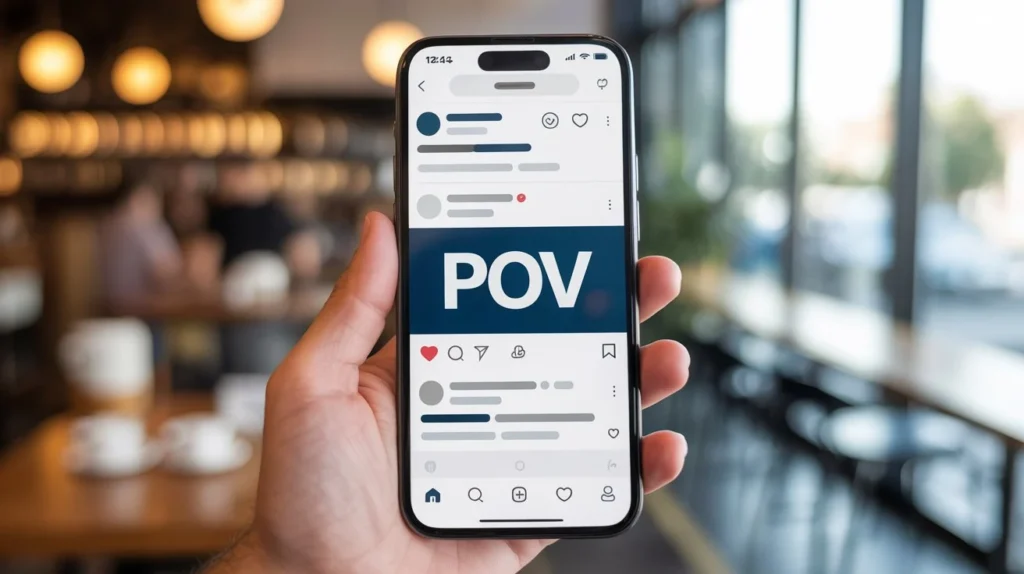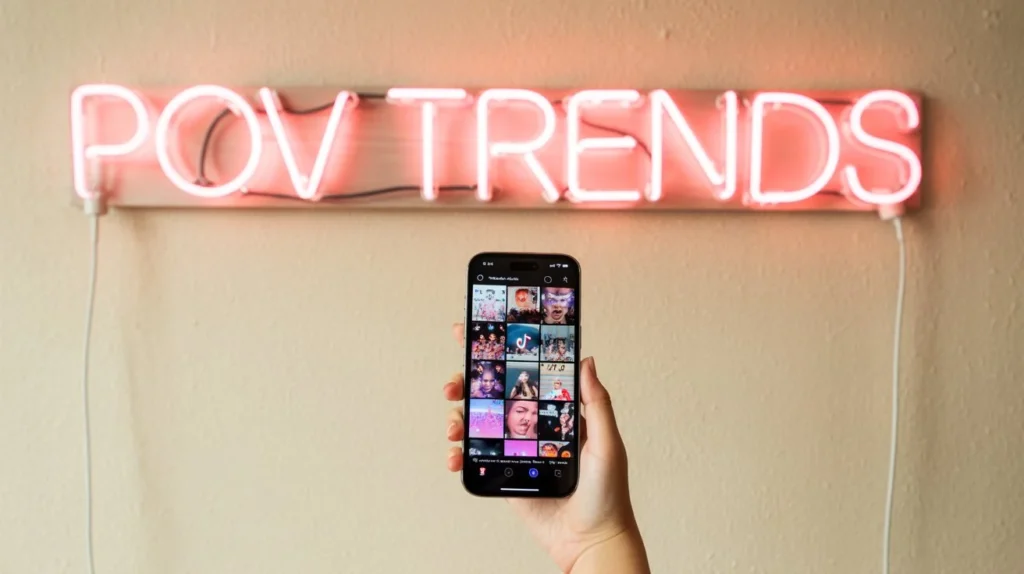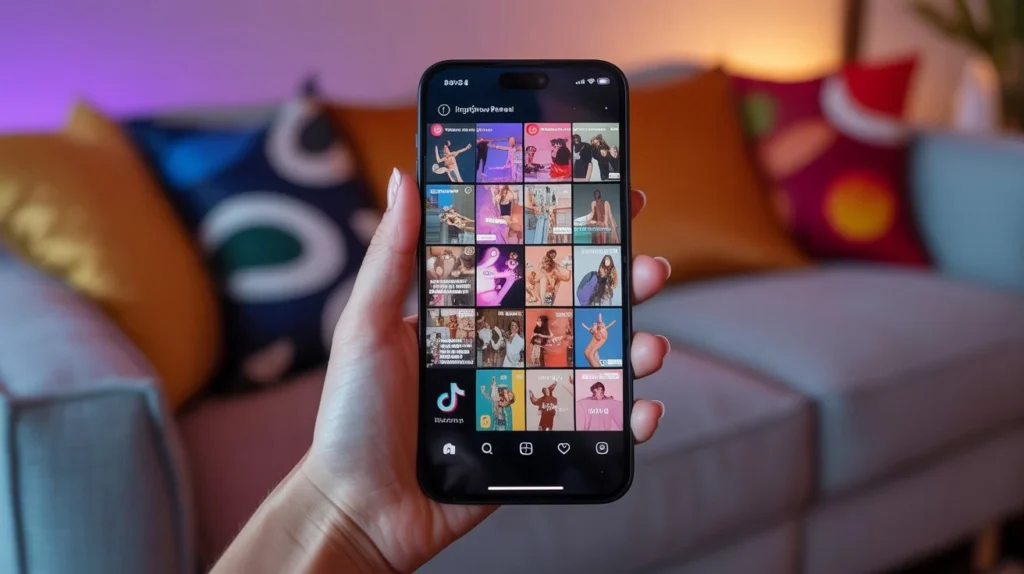If you’ve scrolled through TikTok, laughed at a POV meme, or shared a funny Instagram Reel, chances are you’ve already come across the term POV.
But what exactly does it mean? And why has it become one of the most powerful tools in storytelling, viral content creation, and social media marketing?
This guide breaks down everything you need to know about POV meaning, from its roots in literature to its rise as a dominant trend in short-form video culture.
Whether you’re a content creator, a marketer, or just someone who enjoys memes, this article will help you understand POV content inside and out.
What Does POV Mean?

At its simplest, POV stands for Point of View. It describes the angle or perspective from which a story is told.
- In literature and film, POV refers to the narrator’s perspective—first-person, second-person, or third-person.
- In photography, POV refers to the physical angle or vantage point of the camera.
- In social media, POV has evolved into something unique: a narrative format where the viewer is placed inside the scene.
For example:
- POV: It’s 5 PM and your boss calls for a “quick” Friday meeting.
- POV: You open the fridge and the last slice of pizza is gone.
These captions don’t just describe a situation—they make the viewer feel like they’re experiencing it. That immersive quality is why POV content has exploded across platforms.
POV in Storytelling and Narration
The roots of POV go back to classic storytelling. Writers and filmmakers have always used perspective to create immersion and shape how an audience experiences a story.
- First-person POV: “I walked into the room and felt everyone staring.”
- Second-person POV: “You walk into the room, and all eyes turn toward you.”
- Third-person POV: “She entered the room, and everyone stared at her.”
Notice how each perspective changes the emotional impact.
On social media, the most popular form is second-person POV. Creators address the viewer directly, simulating a personal experience. This gives the content relatability—viewers think, “That’s so me!”
POV in Social Media Content

In the digital age, POV meaning has shifted from just a literary device to a content format. Platforms like TikTok, Instagram Reels, YouTube Shorts, and Twitter (X) thrive on short, engaging clips that grab attention within seconds.
Types of POV Content on Social Media
- POV captions: “POV: You just found out your crush likes you back.”
- POV memes: Images with relatable text overlaid.
- POV GIFs: Short looping clips with a clear emotion or scenario.
- POV reaction shots: Creators acting out funny or exaggerated reactions.
- Skits: Mini-scenes putting the viewer in a situation.
- Duets/Stitches: Adding commentary or reaction to someone else’s POV post.
These formats put the audience perspective front and center. They’re quick, familiar, and shareable—perfect for social media virality.
Why POV Content Goes Viral
So, why does POV content perform so well compared to other formats? The answer lies in psychology, humor, and platform algorithms.
Key Drivers of POV Virality
- Emotional Hook: A relatable emotion (embarrassment, joy, frustration).
- Scenario-Based Content: Everyday moments viewers instantly recognize.
- Humor and Inside Jokes: Especially in workplace humor or student life memes.
- Algorithm Boost: Content that gets fast reactions (likes, shares, comments) is pushed further.
- Mini-Experiences: Users enjoy being immersed in quick, story-like snippets.
“Relatability is the new currency of the internet. When people see themselves in content, they engage, share, and make it viral.”
POV in Marketing and Branding
Brands have quickly realized that POV marketing is not just a trend—it’s a powerful strategy. By creating content from the user’s perspective, companies build trust and foster audience connection.
How Brands Use POV
- Product Experiences: “POV: You’re making the perfect latte at home with our coffee machine.”
- Unboxing Videos: Letting viewers feel like they’re opening the package themselves.
- Behind-the-Scenes Content: Showing a day in the life at the company.
- Customer-First Storytelling: Making the consumer the “main character” of the ad.
Real Examples
- BÉIS Travel (@beis) uses POV to highlight the travel experience through their bags.
- Julia Arceri Interiors (@arceriinteriors) shares “dream kitchen” POV tours.
- Cubicle Thoughts (@cubiclethoughts) posts workplace humor POV memes.
The results? Higher engagement, stronger emotional connection, and better brand recall.
Popular POV Content Formats
Here’s a breakdown of the most common POV content formats you’ll see online:
| Format | Description | Example |
| POV Memes | Image + text overlay simulating perspective | “POV: Your WiFi stops working in a meeting” |
| Captions | Text-driven POV posts | “POV: You hit ‘Reply All’ by accident” |
| GIFs | Short loops capturing reactions | Eye-roll GIF with “POV: When Monday hits” |
| Reels/Shorts | Video skits or immersive scenes | Workplace humor clip |
| Reaction Shots | Exaggerated acting | “POV: The teacher catches you laughing” |
| Duets/Stitches | Creator reactions to other POVs | Replying with “exactly this” |
These formats thrive because they’re instantly digestible and perfect for the short attention spans of modern audiences.
POV Trends and Cultural Formats

The POV trend has become a cultural staple online. Different communities and niches have adapted it to their own style.
Popular POV Trends
- Workplace Humor:
- #toxicworkplace
- #officelife
- #corporatelife
- #toxicworkplace
- Lifestyle POVs:
- Travel experiences
- Morning routines
- Gym and fitness POVs
- Travel experiences
- Pop Culture POVs:
- Reaction to movie scenes
- Viral audio memes
- Reaction to movie scenes
- TikTok POV Trend: Sparked a wave of short, relatable skits—often acting out everyday frustrations or funny scenarios.
Even as trends shift, POV remains evergreen because relatability never goes out of style.
Best Practices for Creating POV Content
Want to make your own viral POV content? Keep these tips in mind:
- Match the Tone to the Platform
- TikTok: playful, casual, humor-heavy
- Instagram: aesthetic, relatable, lifestyle-focused
- Twitter/X: witty, text-based, meme-like
- TikTok: playful, casual, humor-heavy
- Craft Relatable Scenarios
- Universal experiences: workplace jokes, school life, relationships.
- Niche humor: industry-specific memes (marketing, tech, design).
- Universal experiences: workplace jokes, school life, relationships.
- Use Trending Audio & Hashtags
- Pair POV posts with popular songs or sounds for discoverability.
- Add hashtags like #pov, #fyp, #workhumor.
- Pair POV posts with popular songs or sounds for discoverability.
- Remix and Reuse Content
- Repurpose old POV memes into video skits.
- Turn customer feedback into relatable POV captions.
- Repurpose old POV memes into video skits.
Hashtags and Discoverability for POV Content
Hashtags act like semantic indicators for algorithms. They help platforms categorize and push POV content to the right audience.
Popular POV Hashtags
| Category | Hashtags |
| Workplace Humor | #toxicworkplace #corporatelife #officehumor |
| General POV | #pov #fyp #viralcontent |
| Marketing/Tools | #socialmediatools #smmtiktok #contentpillars |
| Lifestyle | #worklife #officelife #relatable |
Using the right hashtags not only increases reach but also signals what community or trend the content belongs to.
Key Takeaways and Future of POV

POV meaning has transformed from a literary concept into a strategic tool for social media storytelling. It works because:
- It creates immersion and relatability.
- It taps into emotional hooks that make content viral.
- It gives brands a way to humanize products and connect with audiences.
And the future? POV isn’t fading. If anything, it’s becoming a pillar of content strategy. Expect to see it evolve with AR/VR experiences, more interactive formats, and even deeper user perspective simulations.
Conclusion
POV is more than just a caption trend—it’s the backbone of modern digital storytelling. By using POV in memes, skits, captions, and branded campaigns, creators and marketers can turn everyday experiences into viral, shareable moments.

Mariah Cannon is the creative mind behind Pikuplab.com, crafting engaging, high-ranking content with expertise and precision.
With a talent for turning ideas into impactful words, Mariah brings value to every article.

